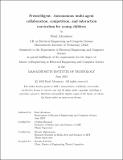Frientelligent: Autonomous multi-agent collaboration, competition, and interaction curriculum for young children
Author(s)
Alcantara, Raul
DownloadThesis PDF (14.67Mb)
Advisor
Breazeal, Cynthia
Alghowinem, Sharifa
Terms of use
Metadata
Show full item recordAbstract
AI has become a critical part of our day-to-day activities, often operating discretely as a core component within our day-to-day devices. Despite its hidden nature, it’s important to teach and learn about it as that would provide transparency about how revolutionary it is, what are their limitations, and how one can leverage its potential responsibly and ethically.
Moreover, introducing AI to students at a young age not only helps them have more understanding and appreciation of this technology, but it gives them a chance to contribute to the community later on. Furthermore, early education in AI can help students develop critical thinking skills, creative problem-solving abilities, and a heightened awareness of the ethical implications surrounding AI.
Unfortunately, there is still a gap in the literature for methods to teach AI to young learners, even when considering the traditional lecture-based style of teaching. To fill this gap, this research creates a novel AI curriculum and pedagogy that delivers AI concepts related to multi-agent interaction to students of ages 9-14. We evaluate the effectiveness of our curriculum in learning AI concepts, and in keeping students engaged throughout.
In the curriculum, where multi-agent collaborate or compete, we teach the concepts of path planning and policy making. We do this by having students use a web-based interface where they’ll be able to control the different policies a robot can take and see how this makes a difference on their behavior. Students were given the opportunity to try two different versions of the same game: A virtual version, where all the interaction happens on a computer; and a physical version, in which they have to rearrange physical bots, "obstacles" and "rewards" (made of Legos) to build their own playfield.
To evaluate the effectiveness of our curriculum, we gave students a pre and postquestionnaire to see how their knowledge of different AI concepts had changed. To evaluate how engaging students found the interface, we took observation notes, had a post-interview where we asked them about their experience, and recorded their interaction to look for signs of excitement/boredom.
For the virtual mode, we found that the majority of students enjoyed the freedom the UI gave them to construct and manipulate their desired elements while witnessing the real-time replication of their actions on their friend’s screen. However, a few of them were overwhelmed by the multitude of available options. Likewise, for the physical mode, students really enjoyed being able to physically interact with different objects, see their changes detected in the interface, and observe the corresponding movements of the robots following the policies they had selected. Similarly, we noticed that overall students’ knowledge and confidence about the AI concepts increased after performing our activity.
We conclude that using a collaborative web-based interface can be a useful way to teach AI concepts and that even though using physical objects for learning makes the experience more engaging, an all-virtual approach gives students more freedom for quick trial-and-error, which increases their learning as well.
There are several ways in which this work can be extended. For instance, introducing customization options for each bot, such as allowing students to give them unique names, could greatly enhance student engagement. Additionally, expanding the library of themes and assets available would provide more opportunities for children to build according to their preferences and desires. By addressing these aspects, we can further enrich the learning experience and make a bigger impact on the student’s learning and perception of AI.
Date issued
2023-06Department
Massachusetts Institute of Technology. Department of Electrical Engineering and Computer SciencePublisher
Massachusetts Institute of Technology